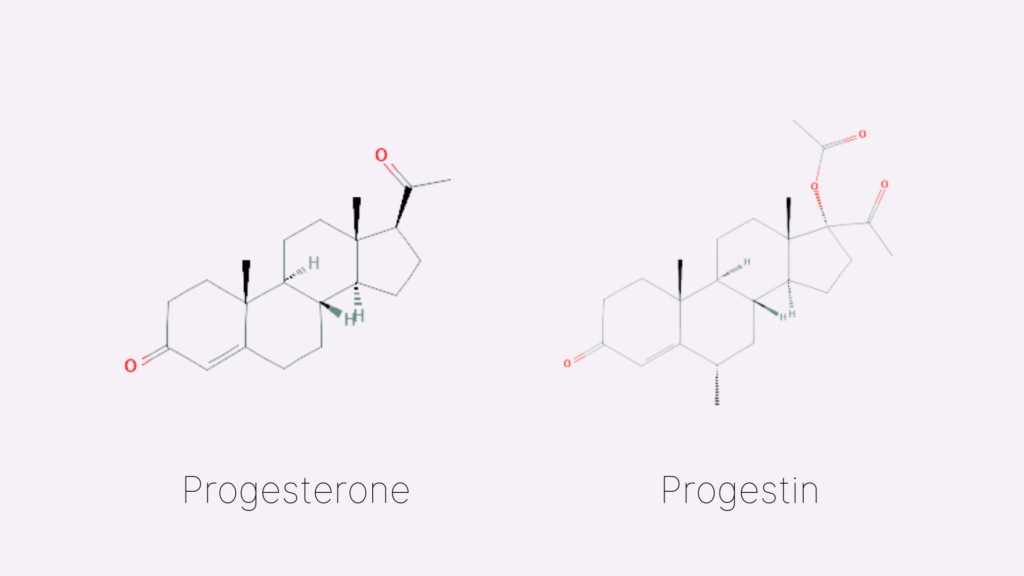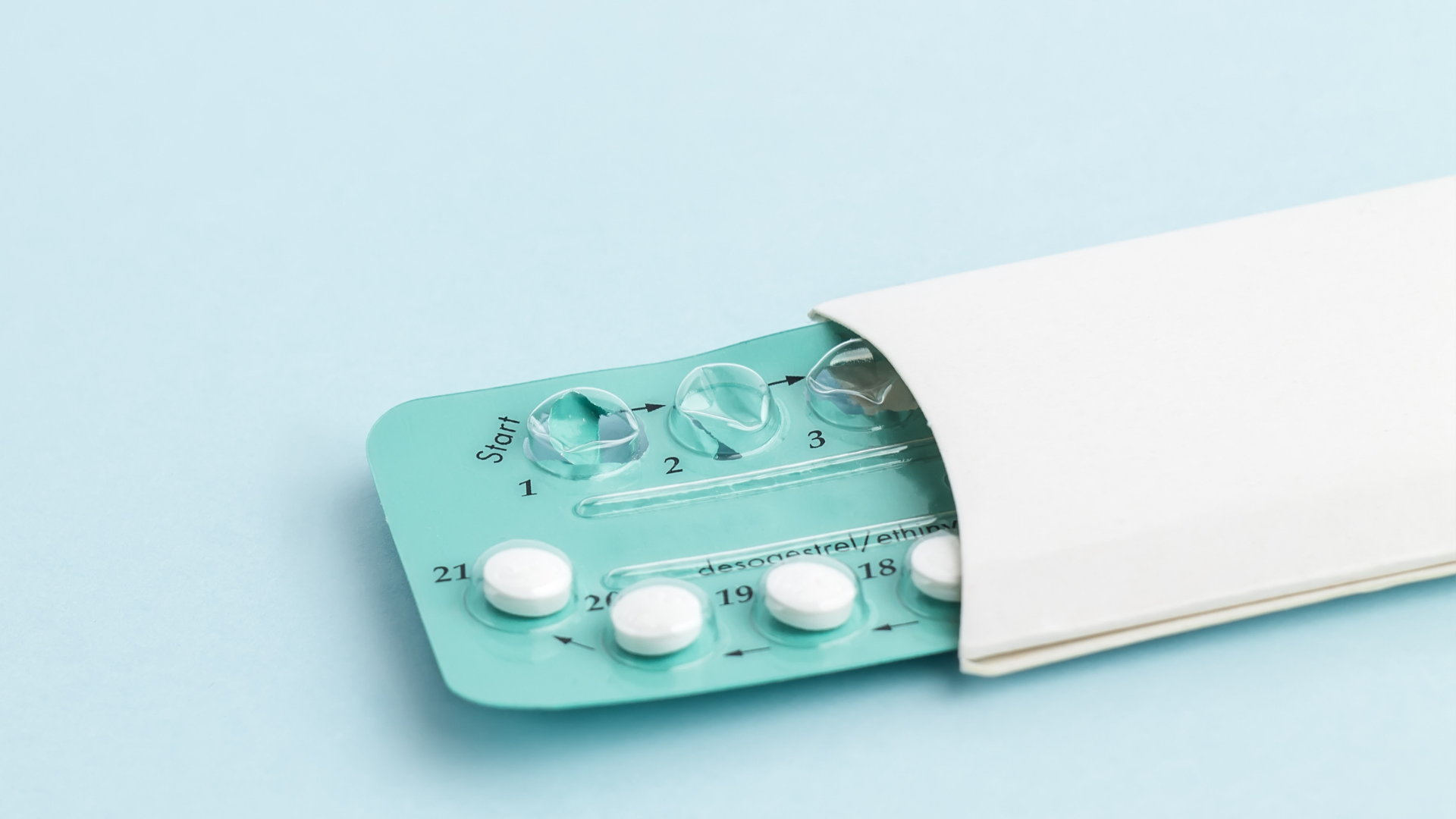As much as the two hormones, progesterone and progestin get thrown around interchangeably, they are two different things and each affects the body differently. In the battle of progesterone vs progestin, the short answer is that though the two have seemingly similar functions in a female body, there is a major difference: progesterone is naturally produced in the body and plays an important role in a female’s reproductive and menstrual health and progestin is synthetically produced version of progesterone that may cause health issues.
This is due to that the fact that while both of these hormones have the same functions to carry out, there are noticeable differences in their structure. And in the light of recent studies, it is being speculated that this structural difference is a probable cause of some serious complications in women, the most common of which is breast cancer.
Progesterone vs Progestin At a Glance
| Progesterone | Progestin | |
| Hormone form | Natural | Synthetic |
| Health range (Adult female) | Pre-ovulation: <0.89 ng/mL Mid-cycle: ≤12 ng/mL Post-ovulation: 1.8-24 ng/mL | Progestin does not naturally occur in females. It is administered through different external sources |
| Effects on the body | Thickens the lining of the uterus Aids fetus nourishment Prevents ovulation during pregnancy Prevents uterine contractions during pregnancy Stimulates breast tissue growth and lactation | Prevents ovulation It keeps the uterine lining thin It thickens the lining of the cervix and prevents sperms to fertilize the egg |
Progestogens vs Progesterone vs Progestin

Let’s cut some some confusion. These three terms are thrown around as if they’re all the same, but they’re not. Progestin is a form of progestogen, which are manmade versions of progesterone. In fact, while progestogens are designed to mimic progesterone, they do not have the same molecular structure. Which, in a sense shouldn’t be all that surprising given that sythetic progestogens are used to do things in the female body, such as prevent pregnacy, which naturally-ocurring progesterone does not do.
| Progesterone | Progestin |
| Naturally-produced in the body | Levonorgestrel |
| Prometrium | Medroxyprogesterone |
| Crinone | Norethindrone |
| Etonogestrel |
Progesterone vs Progestin: What is Progesterone?
Although it is produced both in males and females, progesterone is of the main sex hormones in females. It is an adrenal steroid hormone and is primarily produced by the corpus luteum (outer covering of the female egg) and ovaries, and to a lesser extent from adrenal glands and placenta (in case of pregnancy). It plays an important role in a female’s menstrual, reproductive, and overall health.
What Progesterone Does in the Female Body
Progesterone plays a vital part in the regulation of the female menstrual cycle and the maintenance of early pregnancy. Progesterone is the hormone that makes the female womb viable to carry out the fetus’s growth.
Here’s what progesterone does in the female body:
- Once the ovulation occurs and the egg is released, progesterone prepares the uterine lining (endometrium) for pregnancy and makes it thick by enhancing its blood supply.
- If the egg is not fertilized, the progesterone levels start to diminish causing endometrium lining to shed, resulting in menstruation.
In Case of Pregnancy:
- If the egg is fertilized and gets embedded in the uterine wall, progesterone production continues by the corpus luteum during the initial phases of the pregnancy.
- Progesterone facilitates placenta formation and once it is formed, progesterone is released from the placenta during the remaining period of pregnancy.
- Progesterone enhances blood supply to the endometrium by promoting blood vessels growth.
- Progesterone also stimulates endometrium glands to provide nutrients to the growing fetus.
- Progesterone prevents uterine contractions and facilitates pregnancy continuation.
- Elevated levels of progesterone throughout the pregnancy stop the production of new eggs.
- It also helps stimulate female breast tissue growth, strengthen pelvic floor muscles in order to prepare them for labor, and prevent lactation before delivery.
Where You Can Get Progesterone From?
Even though progesterone is a naturally occurring hormone, you can also get it from external resources. Several creams and pills are available in the market containing natural progesterone. Apart from these resources, you can also enhance your natural progesterone production by making some lifestyle changes.
Here are the most common ways in which progesterone is produced:
- You can get progesterone from changing your dietary intake and eating foods that will boost progesterone production. Some of these food items include beans, nuts, broccoli, brussels sprouts, cabbage, shellfish, walnuts, and bananas.
- Maintaining a healthy body weight increases progesterone production as obesity can cause progesterone levels to drop.
- A stressful mind can hinder progesterone production. Keeping your stress at bay and combating your stressors in time can help with optimizing your progesterone levels.
- Overexercising has been associated with low progesterone levels. Engaging in moderate-intensity physical activities can boost progesterone production.
Progesterone vs Progestin: What is Progestin?
Progestin is a manmade version of progesterone that mimics the properties of progesterone. Progestin is produced synthetically in labs and is used in different contraceptive methods. The need to create progestin was raised because the orally ingested progesterone is cleared from the body rapidly and does not get absorbed to produce desired results. To cope with this problem, a structurally different version of progesterone, which we know as progestin, was created that remains in the body long enough to serve its purpose.
What Does Progestin Do in the Female Body?
Progestin is widely used in hormonal birth control methods either alone or in combination with other hormones and is available in the forms of pills, injections, IUDs (intrauterine devices), and implants.
Even though progestin produces the same effects as progesterone in a female body, due to its different chemical structure it is believed to carry some serious risks, including the risk of developing breast cancer.
Here are some of the common side effects of progestin in the female body:
- Inability to conceive
- Headaches
- Breast tenderness/pain
- Breast lumps
- Depression
- Obesity
- Muscles and joints pain
- Anxiety
- Skin rash/itching
- Difficulty swallowing
- Hand tremors
- Seizures
- Lack of coordination
- Chest pain
- Clay-colored stools
- Bulging eyes
- Blurry vision
- Diarrhea, vomiting, and upset stomach
- Changes in appetite
Where Can You Get Progestin From?
While you can get progesterone from various natural sources and stimulate your body to produce more of it by adopting a few lifestyle changes, progestin can only be administered through external resources.
Here are the most commonly prescribed contraceptives that contain progestin:
- Camila, commonly known as mini pill, contains 0.35 mg of progestin.
- Errin is also in the tablet form and contains 0.35 mg of progestin.
- Alesse is a form of combination contraceptive pill that contains 0.10 mg of progestin.
- Mirena and LILETTA are commonly used IUDs and both contain 52 mg of progestin.
- Jadelle is a commonly used progestin containing implant that releases progestin at a rate of about 100 mcg/day till the end of the first month, about 40 mcg/day till the end of 12 months, and about 30 mcg/day till the end.
Review the full list of progestin-only drugs.
Progestin-Only vs Combo Birth Control
Progestin is available in either isolated form or in combination with another birth control hormone called estrogen. Both types of these contraceptives contain their own risks and benefits.
Progestin-only birth controls prevent pregnancy by inhibiting ovulation.
Progestin-Only
| Pros: | Cons: |
| It does not affect lactation and is safe to use during breastfeeding | It must be taken at the same time daily |
| It is helpful to treat dysmenorrhea (painful menstruation) | It can cause menstrual irregularities |
| Women of any age can use these | It does not prevent sexually transmitted diseases |
Progestin and Estrogen Combo
Some brands use progestin with a combination of other birth control hormones, estrogen. These types of birth control methods prevent pregnancy by making the mucosal lining of the cervix thick and blocking egg fertilization.
Like progestin-only methods, combination methods also have their advantages and disadvantages.
| Pros: | Cons: |
| It is 99% effective in preventing fertilization and 94% effective in preventing pregnancies according to WHO | It can interact with other drugs that you might be taking |
| It is helpful with postmenstrual symptoms (PMS) | It must be taken at the same time daily |
| It reduces the risk of uterine and ovarian cancer | It is not effective in women after 35 years of age |
Frequently Asked Questions (FAQs)
Does birth control cause low testosterone?
Hormnal birth control can cause low testosterone. Because you’re introducing a synthetic form of testosterone, it affects how your body produces natural testosterone. In fact, if a female on hormone birth control takes a hormone test, the results will typically indicate that the female has no little to no testosterone. This is because with an influx of synthetic progestin, a body may stop producing its own progesterone to help avoid a hormone overload.
What are the symptoms of low testosterone in women?
Though low testosterone is generally associated with being a male problem, low testosterone is a problem females as well. It can come with a number. of fsympto, such as sluggishness, weakness, fatigue, disturbed sleep, decreased libido, vaginal dryness, menstrual irregularities, weaker bones, and increased weight. However, because low testosterone in women isn’t well-researched or often discussed, many females never associate these symptoms to a hormonal issue. Learn more about the signs, symptoms, and causes of low testosterone in females.
Is it true that birth control can cause a vitamin D deficiency?
Yes, hormonal birth control can be a cause of a vitamin D deficients. This is because hormonal birth control alters gut absorption and metabolization of vitamin D by the liver and causes its level to drop. Vitamin D plays a vital role within the humane body and without it, or without enough of t, you’re bound to have symptoms from a general sluggishness and low energy to additional hormonal issues and a weakened immune system. Learn more about the connection between birth control and vitamin D deficiency.
Bottom line: Progesterone vs Progestin
Progesterone is an essential hormone for optimal health maintenance, especially in females. While it might be inevitable to use progestin for contraception purposes, progesterone is always a preferable option. In case you are using a progestin-only or a combo hormonal contraceptive method, it’s always wise to be aware of the potential side effects, so that if you do have any you are able to identify the cause and mediate it quickly.

